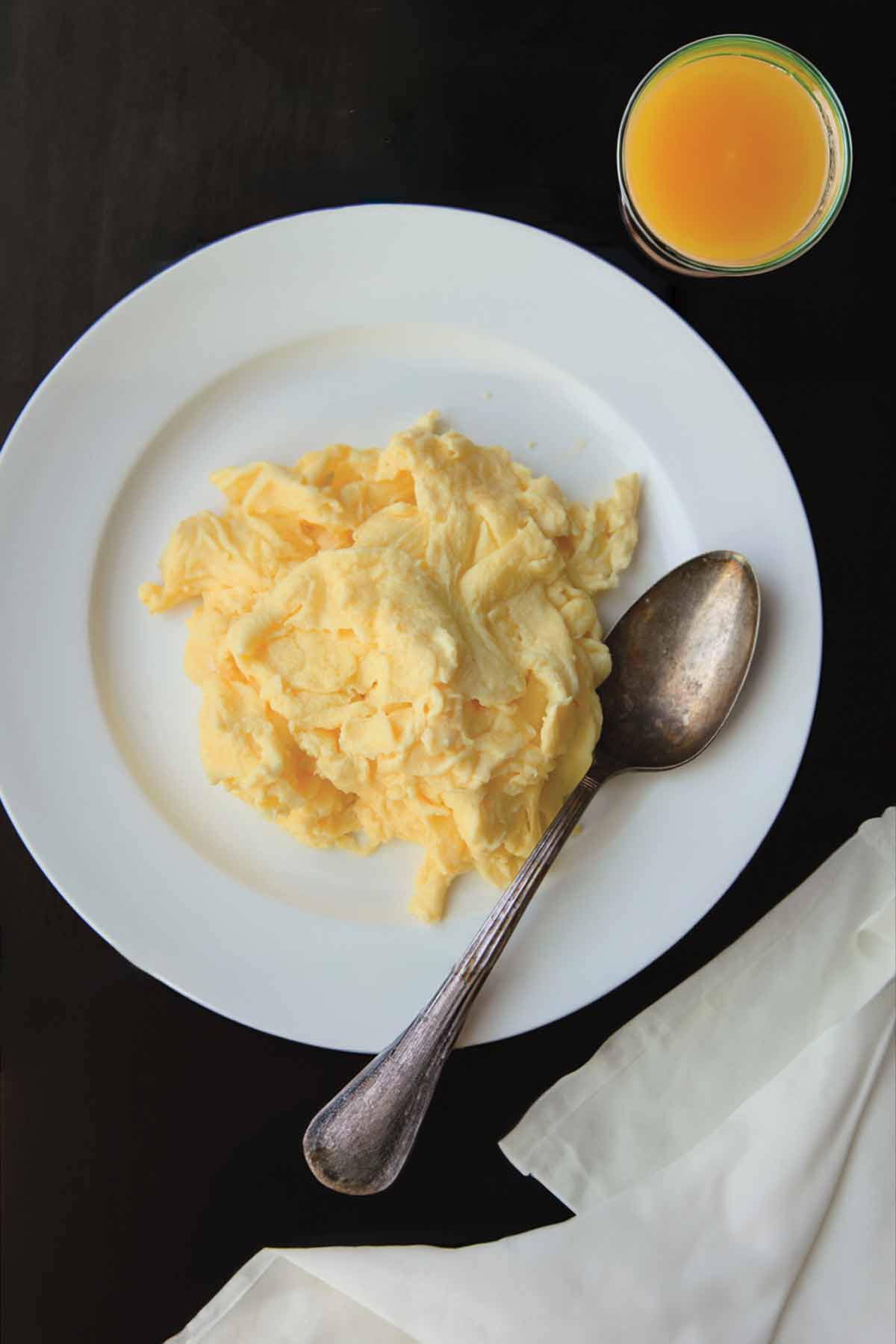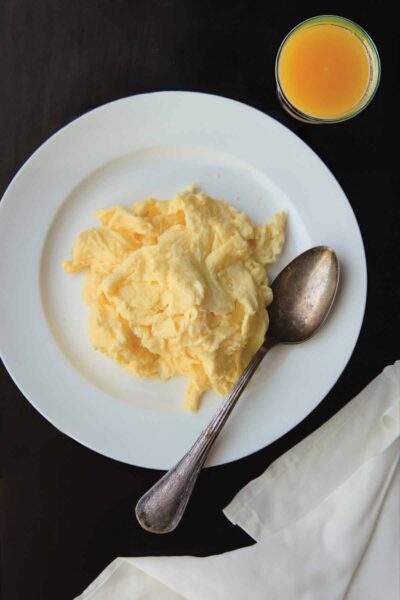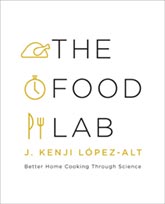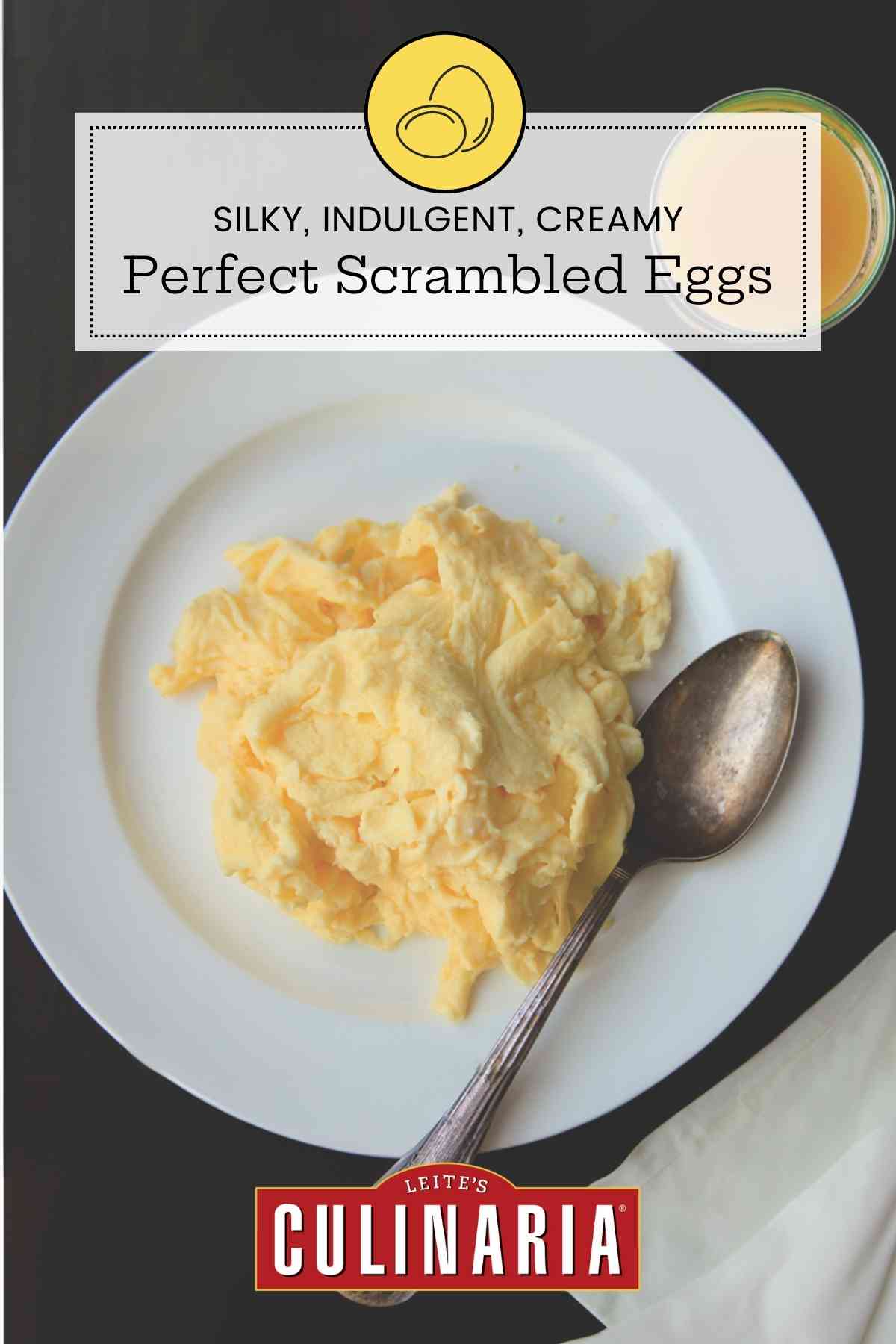
Cooking perfect scrambled eggs is all about controlling the coagulation of egg proteins, the difference being that with scrambled eggs, not only are the proteins in the whites and yolks mixed together, but you also have the opportunity to mix in additional ingredients, as well as to control the way the eggs come together by moving them as they cook. For my testing, I decided to begin with just plain eggs in order to gauge the effects of stirring and other mechanical actions. The only additive I used was butter in the pan to prevent them from sticking.
A few things became clear immediately. The difference between dense and creamy scrambled eggs and light and fluffy scrambled ones has mostly to do with the amount of air they contain at the end. As beaten eggs are heated in a skillet, their proteins begin to set. At the same time, the moisture within them begins to evaporate, causing pockets of steam to build up within the eggs. Vigorous stirring or shaking will cause these pockets of steam and air to rupture, making the eggs denser. So, for the fluffiest scrambled eggs, your goal is to minimize the movement of the eggs in the pan, gently folding and turning them just enough to get them to cook evenly into large, golden, tender curds.
Heat had a great effect on final texture as well. When cooked over very low heat, even gently folded eggs won’t get too fluffy. This is because there’s not enough energy in the pan to cause water vapor to form or to cause air bubbles to expand vigorously. So, for fluffy scrambled eggs, you need to use relatively high heat (though if you let the pan get too hot, you risk overcooking—or, worse, browning—your eggs).
What about common additives to eggs—water, milk, and the like? There are basically two things they can do. First, they add some water to the mix, which makes for fluffier eggs (more water = more vaporization). Dairy ingredients also add fat, which can impeded egg proteins from linking with each other, creating a more tender curd.
Want to Save This?
| ADDITION | EFFECT ON TEXTURE AND FLAVOR | HOW IT WORKS |
|---|---|---|
| Nothing | Eggs cook faster but are tougher | |
| Water | Increased fluffiness, diluted flavor | Extra water means more vaporization |
| Milk | Increased fluffiness and tenderness | Milk is mostly water |
| Cream | Not as fluffy, but rich, almost cheesy | The fat reduces bonding of proteins |
| Cold butter | Ultra creamy and dense | Butter cools the eggs |
With all this data, my light and fluffy perfect scrambled eggs were coming out great. I just had to make sure to whisk in some milk along with the eggs, to use relatively high heat, to keep the stirring and folding minimal, and to make sure to get ’em out of the hot pan before they were completely cooked. Even once out of the pan, moisture will continue to evaporate from the eggs, and the proteins will continue to set higher and tighter. Removing the eggs from the pan when slightly undercooked ensures that they arrive at the table perfectly cooked.–J. Kenji López-Alt
LC What Folks Are Saying About This Recipe Note
“Light, fluffy, slightly moist, perfect scrambled eggs.” “Some of the best scrambled eggs that I have ever made!” “The lightest, fluffiest eggs.” “Works perfectly.” “Very nice.” That’s what folks are saying about this perfect scrambled eggs recipe. Looks like all J. Kenji López-Alt’s efforts, for which we’re quite grateful, were definitely not for naught. [soliloquy id=”101533″]

Perfect Scrambled Eggs
Ingredients
- 8 large eggs
- 3/4 teaspoon kosher salt
- 3 tablespoons whole milk
- 2 tablespoons unsalted butter
Instructions
- Combine the eggs, salt, and milk in a medium bowl and whisk until the mixture is homogeneous and frothy, about 1 minute. Let rest at room temperature for at least 15 minutes. The eggs may darken in color significantly. [Editor's Note: On some rushed mornings and evenings, we confess to having blatantly ignored this direction to wait 15 minutes. And to be honest, the eggs still turned out terrific.]
- Melt the butter in a 10-inch nonstick skillet, carbon-steel skillet, or cast-iron skillet over medium-high heat, swirling the pan as it melts to coat it evenly.
- Add the egg mixture to the pan and wait, without touching the eggs, until the eggs seem to have firmed a little at the edges and on the bottom. You may need to reduce the heat to medium so as to prevent any browning. Scrape the pan with a silicone spatula as the eggs solidify. Then continue to cook, scraping and folding constantly, until the eggs have formed solid, moist curds and no liquid egg remains, about 2 minutes. The eggs should still appear slightly underdone but don’t worry, the residual heat will continue to cook the eggs even after you remove them from the heat and onto a plate. Serve immediately.
Notes
Cooking For Two Variation
Follow the instructions exactly as above except use half the ingredients and a 6- to 7-inch skillet.
Explore More with AI
Nutrition
Nutrition information is automatically calculated, so should only be used as an approximation.
Recipe Testers’ Reviews
Light, fluffy, slightly moist, perfectly cooked scrambled eggs. What could be better for breakfast or a light dinner? The recipe is simplicity itself, and it works. I didn’t really notice that the eggs darkened appreciably after sitting.
This perfect scrambled eggs recipe is a great guide for basic, tasty, light and fluffy scrambled eggs. I cut the recipe in 1/3, using 3 extra-large eggs, and was able to get scrambled eggs on the table for breakfast in no time at all. My eggs were close to room temperature, so I did not let them sit for the 15 minutes. (Sorry, but breakfast rush did not allow for time to let the eggs sit prior to cooking. I don’t see the resting being very realistic to ever execute in our household.)
I’ve always thought I made the best scrambled eggs ever (and a bit more on the creamy side). That is, until I made this version of perfect scrambled eggs! I did whisk the eggs for 1 minute, and I think that is very important in making them so light and fluffy. My eggs were at room temperature before whisking, but I did let them sit for the 15 minutes called for after whisking. I only noticed a slight darkening. I think that waiting to start the scraping and folding helps later on to create solid, moist curds. I did reduce the temperature to medium so that I wouldn’t brown the eggs. I served these right away so they would not continue cooking. Some of the best scrambled eggs that I have ever made. Everyone raved about these!
As simple as this recipe is, it works perfectly, just as the title implies. This is a method I have used for years to make sure to have thoroughly cooked eggs, though nice and fluffy, without feeling dry. The important part of the recipe, to me, is indeed the 1 minute beating to make sure they stay nice and fluffy. In terms of the color change, indeed it does happen a bit, but do not expect a huge difference. Am sure most would not even notice it. The cooking instructions are spot-on as is the timing. I would seriously recommend NOT cooking longer than the called for 2 minutes, as even if they’re off the heat, the eggs will keep cooking and have more of a chance of being dry. This is hands-down the recipe to follow if you like perfect scrambled eggs.
I tested the Cooking For Two variation of these perfect scrambled eggs, which is just a half recipe, as it easily scales for ingredients. I would use medium heat next time. I did like that in a Calphalon nonstick skillet, the eggs released cleanly. The flavor was good, and the height was noticeably fluffy and light. The eggs do darken, and the frothy bubbles go away while you let the whisked eggs rest. Normally I would re-whisk the eggs before putting them in the pan, but since this recipe did not specify that, I simply poured them into the pan as instructed. I think the darkening and the subsequent good behavior in the pan have more to do with the salting and how that affects the proteins than the amount of air—at least that is the best food science explanation I have come across. While most people think they know how to scramble eggs, a method that is simple and has an order is really helpful for consistent results. The only reservations I had were relying on a nonstick pan, which many folks are starting to eliminate from their kitchens (I’ve only kept a couple and seldom use them). The seasoning and texture were very nice. I think you have to watch the temperature, as that will vary with pans and burners, and medium-high was a bit too warm, browning the egg a bit more than you want for a scramble.
I already had a good technique for making fluffy scrambled eggs, or so I thought. However, I was really curious to see what kind of difference a couple of changes would make. I figured that whisking for about 1 minute would get the eggs frothy. It did. I wanted to see if the eggs would darken in color significantly after resting. Indeed, they did. Those were the differences between how I used to make my scrambled eggs and how I will make them now. (In the past, I did whisk my eggs but I poured them into my pan pretty soon after that.) What a difference those two steps make in the finished product. These were the lightest, fluffiest eggs that I have ever made. They actually surpassed the quality of the only place where we have scrambled eggs from the menu because they are part of a chilaquiles platter we sometimes get. I’ve always wondered how they get their eggs so light and fluffy. This might just be it. Whisk them well. Let them sit. I made these a few times, trying different things each time. I found that adding shredded cheese when the eggs were in the skillet and still very, very wet and scraping it into the eggs as I scraped the eggs in the pan, was a perfect way to get that cheese flavor but not overcook the eggs while waiting for the cheese to melt. I also used this method to make a pan of fabulous migas. In terms of simplicity and results, when it comes to the world of scrambled eggs, this is as good as it gets.















Very easy and very tasty!
Thanks, Brooks! So glad you enjoyed them.
They were delicious and good looking!
Wonderful, Singletary!
I learned to cook scrambled eggs from my grandparent’s cook in the late 1940s and I have never had a reason to change. She was cooking for a very large, extended family and the eggs went into a chafer on the buffet and they had to remain fluffy and tender for at least 30 minuets or longer, until everyone had eaten.
It involved heavy cream WHICH IS NOT ADDED TO THE EGGS! The cream is poured into the skillet so it is even from edge to edge, allowed to come to a bubbling across the surface and then the eggs are added. From there on, it is pretty much the same as every other method.
It’s on my blog, see the “Website” pane.
Also on my blog, How to cook the perfect sausage patty.
Brilliant, Andrea! I would have never thought about that. But I love it. Thank you for sharing!